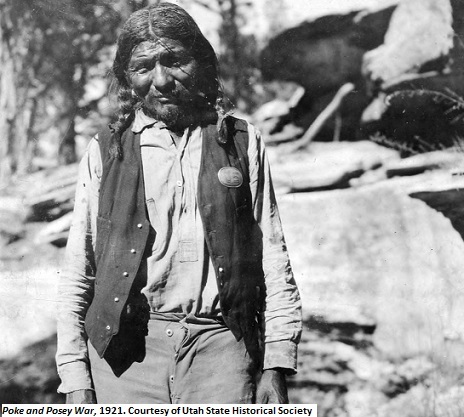Dublin Core
Title
Description
Tensions between white and Native American populations in San Juan County escalated over limited resources and mutual misunderstanding. The eventual armed conflict between the two groups has been called “The Last Indian Uprising”.
In 1923, fighting broke out in southeastern Utah between white settlers and a mixed band of Ute and Paiute Indians led by a man named Posey. This wasn’t the first time armed conflict had engulfed the area. Native Americans and whites had clashed several times before, but what sparked the armed violence this time was the arrest and detention of two of Posey’s band for supposedly killing livestock. When the two men made a daring escape partway through their trial, the sheriff deputized a posse of white citizens to round up local Utes and Paiutes and imprison them, first, in the basement of the Blanding school, and then in an outdoor stockade. Those Native Americans who weren’t captured fought back under Posey’s leadership. One lawman had his horse shot out from under him, while a group of deputies, chasing Posey’s men in a Model T Ford, barely escaped a hailstorm of bullets with their lives. The tide, however, eventually turned against Posey and his band. Within the space of a few weeks, Posey had been killed and the fighting ended.
So what sparked what some now call the Posey War? The white settlement of San Juan County, beginning in the 1880s, had stretched the region’s already limited resources to their breaking point, forcing the county’s Native American population to give up their hunter-gatherer lifestyle and rely almost solely on the white settlers for provisions. This new way of life sowed the seeds of friction and mistrust, as claims of livestock rustling and robbing were leveled against the region’s Utes and Paiutes. Their resistance to white domination escalated the mutual misunderstanding and eventually led to armed conflict.
Creator
Source
Image: Poke and Posey War, 1921. Image of Posey, the leader of insurgent Indians in Posey War in San Juan County. Courtesy of Utah State Historical Society.
_______________
See news reports about the Posey War in the following editions of the Moab Times-Independent: March 22, 1923; March 29, 1923; April 5, 1923; April 14, 1923; April 26, 1923; and May 3, 1923. Also see Robert S. McPherson’s entry on the Posey War in the online Utah History Encyclopedia; and Robert S. McPherson, “Paiute Posey and the Last White Uprising,” Utah Historical Quarterly 53 (Summer 1985): 248-267.

